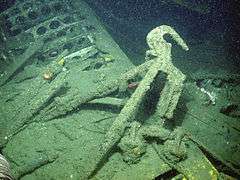USS Macon (ZRS-5)
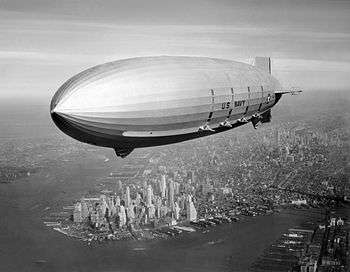 USS Macon over New York City in 1933 | |
| History | |
|---|---|
| Name: | USS Macon |
| Namesake: | Macon, Georgia |
| Builder: | Goodyear-Zeppelin Company, Springfield Township, Ohio |
| Laid down: | May 1931 |
| Launched: | 11 March 1933 |
| Sponsored by: | Mrs William A. Moffett |
| Commissioned: | 23 June 1933 |
| Struck: | 26 February 1935 |
| Identification: | Hull number: ZRS-5 |
| Fate: | Crashed off the coast of California, 12 February 1935 |
| General characteristics (as built) | |
| Class and type: | Akron-class airship |
| Displacement: | 7,401,260 cu ft (209,580.3 m3) |
| Length: | 785 ft (239.3 m) |
| Beam: | 133 ft (40.5 m) (hull diameter) |
| Draft: | 146 ft 5 in (44.6 m) (height) |
| Installed power: | 560hp per engine |
| Propulsion: |
|
| Speed: | |
| Range: | 5,940 nmi (11,000 km; 6,840 mi) at 10 knots (19 km/h; 12 mph) |
| Complement: | 60 |
| Armament: | 8× .30-cal machine guns |
| Aircraft carried: | 5 Curtiss F9C Sparrowhawk |
| Aviation facilities: | 1 aircraft launch trapeze |
The USS Macon (ZRS-5) was a rigid airship built and operated by the United States Navy for scouting and served as a "flying aircraft carrier", designed to carry biplane parasite aircraft, five single-seat Curtiss F9C Sparrowhawk for scouting or two-seat Fleet N2Y-1 for training. In service for less than two years, in 1935 the Macon was damaged in a storm and lost off California's Big Sur coast, though most of the crew were saved. The wreckage is listed as the USS Macon Airship Remains on the U.S. National Register of Historic Places.
Less than 20 ft (6.1 m) shorter than Hindenburg, both the Macon and "sister ship" the USS Akron (ZRS-4) were among the largest flying objects in the world in terms of length and volume. Although the hydrogen-filled Hindenburg and the LZ 130 Graf Zeppelin II was longer, the two sisters still hold the world record for helium-filled airships.
Construction

The USS Macon was built at the Goodyear Airdock in Springfield Township, Ohio by the Goodyear-Zeppelin Corporation.[1] Because this was by far the biggest airship ever to be built in America, a team of experienced German airship engineers—led by Chief Designer Karl Arnstein—instructed and supported design and construction of both the U.S. Navy airships Akron and Macon.[2]
The Macon had a structured duraluminum hull with three interior keels.[3] The airship was kept aloft by 12 helium-filled gas cells made from gelatin-latex fabric. Inside the hull, the ship had eight German-made Maybach 12-cylinder, 560 hp (418 kW) gasoline-powered engines that drove outside propellers.[4] The propellers could be rotated down or backwards, providing an early form of thrust vectoring to control the ship during takeoff and landings. The rows of slots in the hull above each engine were part of a system to condense out the water vapor from the engine exhaust gases for use as buoyancy compensation ballast to compensate for the loss of weight as fuel was consumed.
Service history
Christening and commissioning
The Macon was christened on 11 March 1933, by Jeanette Whitton Moffett, wife of Rear Admiral William A. Moffett, Chief of the U.S. Navy's Bureau of Aeronautics.[5] The airship was named after the city of Macon, Georgia, which was the largest city in the Congressional district of Carl Vinson, then the chairman of the House of Representative's Committee on Naval Affairs.[4]
The airship first flew one month later, shortly after the loss of the Akron in which Admiral Moffett and 72 others were killed. Macon was commissioned into the U.S. Navy on 23 June 1933, with Commander Alger H. Dresel in command.
1933

On 24 June 1933, the Macon left Goodyear's field for Naval Air Station (NAS) Lakehurst, N.J., where the new airship was based for the summer while undergoing a series of training flights.[6]
The Macon had a far more productive career than the Akron, which crashed on 4 April 1933. The commanders of the Macon developed the doctrine and techniques of using her on-board aircraft for scouting while the airship remained out of sight of the opposing forces during exercises.[7] The Macon participated in several fleet exercises, though the men who framed and conducted the exercises lacked an understanding of the airship's capabilities and weaknesses.[8] It became standard practice to remove the landing gear of the Sparrowhawks while aboard the airship and then replace it with a fuel tank, thus giving the aircraft 30 percent more range.[9]
- Some design details
 Inside Macon's aircraft hangar
Inside Macon's aircraft hangar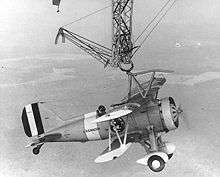 Sparrowhawk scout/fighter aircraft on its exterior rigging
Sparrowhawk scout/fighter aircraft on its exterior rigging Inside Macon's secondary control node
Inside Macon's secondary control node Aerial reconnaissance "spy car" observer's basket which could be lowered below clouds with a tether.
Aerial reconnaissance "spy car" observer's basket which could be lowered below clouds with a tether.
_off_San_Diego_in_October_1935.jpg)
The Macon first operated aircraft on 6 July 1933 during trial flights out of Lakehurst, New Jersey. The planes were stored in bays inside the hull and were launched and retrieved using a trapeze.[10]
The airship left the East Coast on 12 October 1933, on a transcontinental flight to her new permanent homebase at NAS Sunnyvale (now Moffett Federal Airfield) near San Francisco in Santa Clara County, California.[11]
1934
In 1934, two two-seat Waco UBF XJW-1 biplanes equipped with skyhooks were delivered to the USS Macon.
In June, 1934, Lieutenant Commander Herbert V. Wiley took command of the airship, and shortly afterwards he surprised President Franklin D. Roosevelt (and the Navy) when the Macon searched for and located the heavy cruiser Houston, which was then carrying the president back from a trip to Hawaii. Newspapers were dropped to the President on the ship, and the following communications were sent back to the airship: "from Houston: 1519 The President compliments you and your planes on your fine performance and excellent navigation 1210 and 1519 Well Done and thank you for the papers the President 1245." The commander of the Fleet, Admiral Joseph M. Reeves, was upset about the matter: but the Commander of the Bureau of Aviation, Admiral Ernest J. King[12] was not. Wiley, one of only three survivors of the crash of the Akron, was soon promoted to commander, served as the captain of the battleship West Virginia in the final two years of World War II, and then retired from the Navy in 1947 as a rear admiral.
Loss
Leading up to the crash
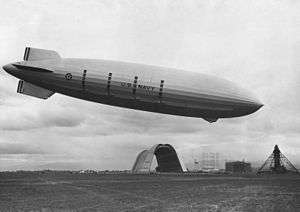
In April 1934,[13] during a crossing of the continent, the Macon was forced to climb to 6,000 ft (1,800 m) to clear mountains in Arizona. As the ship's pressure height (the height at which the gas cells would start to leak and eventually rupture due to pressure difference) was less than 3,000 ft (910 m), a large amount of helium was vented in reaching this altitude. To compensate for the loss of lift, 9,000 lb (4,100 kg) of ballast and 7,000 lb (3,200 kg) of fuel had to be dumped. The Macon was being flown 15,000 lb (6,800 kg) "heavy" and was operating at full power not only in order to have sufficient dynamic lift, but also to have enough control to fly in the severe turbulence through a mountain pass near Van Horn, Texas. Following a severe drop, a diagonal girder in ring 17.5, which supported the forward fin attachment points, failed. Rapid damage control by Chief Boatswain's Mate Robert Davis repaired the girders before further failures could occur. The Macon completed the journey safely but the buckled ring and all four tailfins were judged to be in need of strengthening. The appropriate girders adjacent to the horizontal and lower fins were repaired, but the repairs to the girders on either side of the top fin were delayed until the next scheduled overhaul, when the adjacent gas cells could be deflated.
Crash
On 12 February 1935, the repair process was still incomplete when, returning to Sunnyvale from fleet maneuvers, the Macon ran into a storm off Point Sur, California. During the storm, the ship was caught in a wind shear which caused structural failure of the unstrengthened ring (17.5) to which the upper tailfin was attached. The fin failed to the side and was carried away. Pieces of structure punctured the rear gas cells and caused gas leakage. The commander, acting rapidly and on fragmentary information, ordered an immediate and massive discharge of ballast. Control was lost and, tail heavy and with engines running full speed ahead, the Macon rose past the pressure height of 2,800 ft (850 m), and kept rising until enough helium was vented to cancel the lift, reaching an altitude of 4,850 ft (1,480 m).[14] It took 20 minutes to descend and, settling gently into the sea, the Macon sank off Monterey Bay. Only two crew members were lost thanks to the warm conditions and the introduction of life jackets and inflatable rafts after the Akron tragedy.[15][16][17] Radioman 1st Class Ernest Edwin Dailey jumped ship while still too high above the ocean surface to survive the fall and Mess Attendant 1st Class Florentino Edquiba drowned while swimming back into the wreckage to try to retrieve personal belongings. An officer was rescued when Commander Wiley swam to his aid, an action for which he was later decorated.[18]
The Macon, having completed 50 flights since being commissioned, was stricken from the Navy list on 26 February 1935. Subsequent airships for Navy use were of a nonrigid design.
A depiction of the crash by artist Noel Sickles was the first piece of art sent over the wire by the Associated Press.
Wreck site exploration
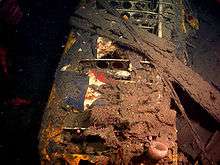
The Monterey Bay Aquarium Research Institute (MBARI) succeeded in locating and surveying the debris field of Macon in February 1991, and was able to recover some artifacts.[19] The exploration included sonar, video, and still camera data, as well as some recovery of parts.
In May 2005, MBARI returned to the site as part of a year-long research project to identify archeological resources in the bay. Side-scan sonar was used to survey the site.
2006 expedition
A more complete return, including exploration with remotely operated vehicles and involving researchers from MBARI, Stanford University, and the National Oceanic and Atmospheric Administration's Office of National Marine Sanctuaries, took place in September 2006.[20][21] Video clips of the expedition were made available to the public through the OceansLive Web Portal, a service of NOAA.
The 2006 expedition was a success, and revealed a number of new surprises and changes since the last visit, ~15 years previously. High-definition video and more than 10,000 new images were captured, which were assembled into a navigation-grade photomosaic of the wreck.[22]
Protection
|
U.S.S. Macon Airship Remains | |
|
Sky hook visible on the remains of one of the Macon's F9C-2 biplanes (2006) | |
   | |
| Location | Monterey Bay National Marine Sanctuary, Big Sur, California |
|---|---|
| Area | 5654.7 square meters[23] |
| NRHP Reference # | 09001274[24] |
| Added to NRHP | 29 January 2010[24] |
The wreckage of the Macon was listed in the National Register of Historic Places on 29 January 2010.[24] The location of the wreck site remains secret and is within a marine sanctuary, the Monterey Bay National Marine Sanctuary. It is not accessible to divers due to depth (1,500 ft or 460 m).[23][25][26]
The U.S. National Park Service states:[27]
When the USS Macon was christened on 11 March 1933, the rigid airship was the most sophisticated of the Navy’s lighter-than-air (LTA) fleet. The Macon exhibited the highest expression of naval LTA technology during the ship's short career. At 785 feet in length, the airship’s size captured American fascination during flyovers of U.S. communities as chronicled in numerous advertisements, articles, and newsreels. The dramatic loss of the Macon and sister ship Akron within two years of each other contributed to the cancellation of the Navy’s rigid airship program. The archeological remains of the USS Macon lie off California’s Big Sur coast in NOAA’s Monterey Bay National Marine Sanctuary. The site also contains the remains of four of the airship’s squadron of small Curtiss F9C Sparrowhawk scout aircraft which the Macon carried in an internal hangar bay.
The site was listed on the U.S. National Register of Historic Places on 29 January 2010.[24] The listing was announced as the featured listing in the National Park Service's weekly list of 12 February 2010.[28]
In popular culture
The Macon is featured as a setting and key plot element in Max McCoy's novel Indiana Jones and the Philosopher's Stone; Indiana Jones travels aboard the Macon while it makes a transatlantic flight to London.
The Macon is featured toward the end of the 1934 Warner Bros. film Here Comes the Navy starring James Cagney, Pat O'Brien and Gloria Stuart. Cagney's character is assigned to the Macon after serving on the USS Arizona, which is featured heavily in the film.
The crash of the Macon is depicted at the beginning of the 1937 film The Go Getter, featuring George Brent as her helmsman.
See also
- List of airship accidents
- Hangar One (Mountain View, California), built to house the Macon
References
- ↑ Akron-Summit County Public Library, Summit Memory. "Goodyear-Zeppelin Corporation, Facts About the World's Largest Airship Factory & Dock". Retrieved 2008-11-15.
- ↑ Akron-Summit County Public Library, Summit Memory. "Dr. Karl Arnstein photo and biography". Retrieved 2008-11-15.
- ↑ Monterey Bay National Marine Sanctuary, Submerged Maritime Heritage Resource: USS Macon. "The Marvel of the USS Macon". Retrieved 2008-11-15.
- 1 2 "U.S.S. Macon". Moffett Field Museum. Retrieved November 13, 2008.
- ↑ "USS Macon christening photograph". Akron-Summit County Public Library. Retrieved November 15, 2008.
- ↑ "Macon Comes East; Her Voyage Calm: New Queen of Navy's Air Fleet Docked at Lakehurst After Smooth Flight from Ohio". The New York Times, 25 June 1933, p. 3
- ↑ Robinson 1973, p. 242.
- ↑ Robinson 1973, p. 243.
- ↑ Robinson 1973, p. 244.
- ↑ USS Macon and Sparrowhawks - arrival and departure via trapeze
- ↑ "Macon Takes Off for Flight to the West: Dirigible Leaves Lakehurst for Its Permanent Station at Sunnyvale, Calif" The New York Times, 13 October 1933, p. 21
- ↑ the Chief of Naval Operations during World War II,
- ↑ http://www.airships.net/us-navy-rigid-airships/uss-akron-macon
- ↑ Robinson 1973, p. 246.
- ↑ Various sources cite the total number of passengers aboard at the time of the incident between 76 and 81 crew and officers.
- ↑ Eckstein, Megan (19 August 2015). "Exploring the Wreck of USS Macon, The Navy's Last Flying Aircraft Carrier". USNI News. United States Naval Institute. Archived from the original on 5 March 2016. Retrieved 22 May 2016.
- ↑ Associated Press (13 February 1935). "DIRIGIBLE MACON FORCED DOWN AT SEA; SHIPS RUN TO RESCUE OF HER CREW". Leominster Daily Enterprise. San Francisco. Archived from the original on 23 May 2016. Retrieved 23 May 2016.
- ↑ Herbert V. Wiley, Captain USN, USS West Virginia, 1944-1945
- ↑ "MBARI's First Decade: A Retrospective" (PDF). Monterey Bay Aquarium Research Institute. c. 1997. Retrieved 2006-10-04. (page 11)
- ↑ "Expedition To Probe Sunken Airship". KSBW-TV. 13 September 2006. Retrieved 2006-10-04.
- ↑ "Studying a Navy Relic, Undisturbed for Nearly 60 Years". The New York Times. 3 October 2006. Retrieved 2011-12-06.
- ↑ "USS Macon Exploration Findings Unveiled". KSBW-TV. 27 September 2006. Retrieved 2006-10-04. (includes slideshow)
- 1 2 Bruce G. Terrell (10 February 2009). "National Register of Historic Places Registration: USS Macon" (PDF). National Park Service. Retrieved 2010-05-18. (39 pages, with 20 historic and wreckage exploration photos)
- 1 2 3 4 "Announcements and actions on properties for the National Register of Historic Places for February 12, 2010". Weekly Listings. National Park Service. 12 February 2010. Retrieved 2010-05-18.
- ↑ "2006 USS Macon Expedition". Sanctuaries.noaa.gov. Retrieved 2012-11-07.
- ↑ "NOAA News Online (Story 2708)". Noaanews.noaa.gov. 27 September 2006. Retrieved 2012-11-07.
- ↑ "Weekly Highlight 02/12/2010 USS Macon Airship Remains, Monterey County, California".
- ↑ "Weekly List Actions". National Park Service. Retrieved 2010-05-18.
Bibliography
- Robinson, Douglas H., and Charles L. Keller. "Up Ship!": U.S. Navy Rigid Airships 1919-1935. Annapolis, Maryland: Naval Institute Press, 1982. ISBN 0-87021-738-0
- Robinson, Douglas H., Giants in the Sky. Henley-on-Thames: Foulis, 1973. ISBN 0 85429 145 8
- Miller, Henry M., "Human Error: Road to Disaster", Canyon Books, 1975, ISBN 0-89014-128-2
- Smith, Richard K. The Airships Akron & Macon (Flying Aircraft Carriers of the United States Navy), United States Naval Institute: Annapolis, Maryland, 1965
External links
| Wikimedia Commons has media related to: |
- Airships.net: U.S.S. Akron and Macon
- A 1964 KPIX-TV documentary about the U.S.S. Macon
- U.S. Naval Historical Center pages on ZRS-5
- Lucidcafe.com has a good page with some additional photos of the ship and crew called USS Macon: The U.S. Navy's last dirigible
- Casualties: US Navy and Marine Corps Personnel Killed and Injured in Selected Accidents and Other Incidents Not Directly the Result of Enemy Action
- Uncovering the USS Macon: The Underwater Airship" Der Spiegel
- Construction of the USS Macon Airship (photo gallery)
- KQED has put together a video with info about USS Macon, historical and wreck-site footage, as well as info about the new zeppelin that is flying over the San Francisco Bay Area.
- Moffett Field Museum near San Jose, CA has an exhibit dedicated to the USS Macon.
This article incorporates text from the public domain Dictionary of American Naval Fighting Ships.
Coordinates: 36°17′27″N 121°59′52″W / 36.29083°N 121.99778°W
